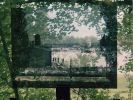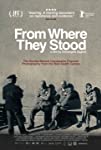Eye For Film >> Movies >> From Where They Stood (2021) Film Review
From Where They Stood
Reviewed by: Anne-Katrin Titze

Christophe Cognet’s extraordinary and far-reaching From Where They Stood (À Pas Aveugles) begins at a pond in the rain surrounded by birch trees. Little white pebbles appear to have been washed ashore, only they are not stones and where they originate is soon revealed. The earth spits them out. The hard physical remains carry history.
A few clandestine photographs, taken by courageous prisoners in Dachau, Buchenwald, Dora, Ravensbrück, and Auschwitz-Birkenau are at the core of the documentary in which Cognet with the help of his cinematographer Céline Bozon, his team, experts, and translators at the respective memorial sites attempts to find out more about the individual circumstances. In reconstructing the angles of where and when the photographs were taken, an important path into the past opens up.

The life-size transparent prints of the images when placed at the original sites, have an uncanny, provocative and very bracing effect. Tourists or visitors, the difference mostly easy to spot, to the concentration camp memorial sites walk by and for seconds the past and present in our eyes merge into a tinted timelessness of an always now.
Claude Lanzmann’s masterpieces, Four Sisters, The Last Of The Unjust, and of course the incomparable Shoah, for which no archival footage was ever used, broke the ground for the sense of the perpetual present, which is the prerequisite to begin to understand. Alain Resnais with his devastating Nuit et Brouillard, and I would add Hiroshima Mon Amour and its focus on forgetting and remembering, are also never far.
Like the bone fragments, the victims are here on the screen as a ghostly physical presence. Their perspective and agency are given space. The natural sound of birdsong and the wind roughing up the leaves accompany the images which makes it easy to concentrate on the details.
There is no wrongheaded reenactment with actors, no freshly mixed barking of guards or their dogs, no hovering music of doom to signal to the uninformed or half-attentive that this was bad. I felt gratitude and relief that this documentary was not utilising these misguided techniques.
Discussions here are about circumstances, such as trying to decipher the time of day or the day of the week when the 50 pictures taken between 1943 and 1944 by Czech prisoner Rudolf Císar in Dachau could possibly have been shot, before they were smuggled out, together with samples of human skin to archive the atrocities. On one, the placement of the shadows speak of noon in the fall and the lack of people makes a Sunday likely.
1944, Jean Brichaux, a prisoner from Belgium who survived Dachau, took photos of a roll call of newly arrived French deportees. We see the crematorium. An unknown young prisoner’s body posture. At the “Jedem das Seine” gate a teenage boy takes a selfie with his phone, a schoolgirl with long red hair stands behind him. I am thinking that neither woman in Paul Celan’s Deathfuge shares her hair colour and how different elements in this documentary look as if they were on fire. Such as the rusty doors on the infirmary reconstructed by the Dachau Memorial Center and the autumn leaves in the trees in Ravensbrück at the site where the medical experiments took place.
In Buchenwald George Angeli took 11 photographs on a Sunday in June 1944. He took them “with his body, not his eyes”, wrapped in newspaper under his arm, so that the camera could be hidden from the watchtower. We see Goethe’s Oak, and realize how much the trees have seen. A school group walks by where the photograph is installed and the overlapping images for a split second make it impossible to distinguish who is prisoner and who a spectre from the 21st century.
Are the branches in the image on the screen then or now? How could the photographer have been so close to the other people? On the left, first came the cinema, then the brothel, we are told. The arrant horror of these words. The cinema was used to show propaganda movies and as a torture chamber, in the brothel women brought over from the Ravensbrück camp were raped. Block 46 was for the medical atrocities. In Angeli’s images the smoke from the crematorium is lucidly visible. The crematoria were always kept active.
At the site of Dora-Mittelbau, Wenzel Polak took seven secret photos in 1944. Christophe Cognet walks through the forest stopping at an overgrown foundation, concrete slabs on the ground where once a long barrack stood. This is where Polak took portraits of two of his fellow prisoners and of himself. The men smile and strike relaxed poses, hands in pockets, similar to those captured by Cisar in Dachau, with only their striped clothing giving away the circumstances. Cognet puts it well: the act of regaining control of one’s image is resistance in itself.
The clandestine photographs, taken by Joanna Szydłowska and smuggled out by resistance fighter Germaine Tillion, of three women in Ravensbrück tell yet another story. The women were known as the “rabbits” due to the horrific medical experiments they had to endure. In the photographs, which come in pairs, one of the injury, one of the entire body from a little farther away, individuality, strength, and kindness amongst inhumanity are all on display. The rabbits were given the nicest, most elegant coats by their fellow prisoners because they had gone through so much. Humans cannot be limited to victimhood, to the bulges in their legs, the reduced bones, the cuts in their bodies.
The film informs us of their fates after the liberation. Maria Kusmierczuk became a radiologist in Gdansk, Bogumila Jasuik worked in sales in Warsaw, while the smiling Barbara Pietrzyk, a dancer and the youngest, who at 16 has the face of an old woman, never recovered from the torture experiments and died as a result of the injuries in 1947 at the age of 21. Photographer Joanna Szydłowska survived and became an art teacher once more.
A couple in the present, sneaker-clad, poses for a picture. The woman’s pants have the length of swim trunks and the man’s below-the-knee cargo shorts, unbelievably, sport vertical stripes in blue and white. Another man and another woman hurry by to also have their picture taken at the same spot to post on their social media accounts. Only then the camera moves up from the grotesque posers to show that they stand at the Arbeit macht frei gate in Auschwitz. All that goes into image making.
Cognet and his team are there to better understand the perspectives of Alberto Errera’s four famous Sonderkommando photographs of Auschwitz-Birkenau, taken from within the gas chamber of crematorium V and surrounding it, likely in August 1944. Cropped, enlarged, with women’s faces and breasts retouched, they have gone around the world. Again and again we are reminded of how dreadfully successful the plan by the Nazis was to keep their factories of horrors hidden.
Is that a newborn a woman is carrying? Is the woman in the front, who makes me think of the statuesque logo at the start of Columbia Pictures, aware where she is going? Is one of the bodies removed from the gas chamber maybe still alive and is this why the members of the Sonderkommando are scratching their heads? What goes on inside the mind of the SS inspector with the baggy trousers? Many questions flare up. Most of the trees were already there then. The impossible photograph from within.
From Where They Stood gives back the gaze to those who dared to record what they witnessed. The weighty act of looking, which sometimes needs no eyes, is returned to the subjects. Victims are not objects, body injuries, abstractions. The bones washed up from the earth near the pond outside the crematorium will sing of it eternally.
Reviewed on: 18 Jul 2022















